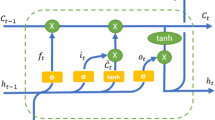Abstract
Air-quality in urban areas is one of the most critical concern for governs. Wide spectrum measures are implemented in relation to this issue, from laws and promotion of renewal of heating and transport systems, to stablish monitoring and prediction systems. When air-pollutant levels excess from healthy thresholds, traffic limitations are activated with non-negligible nuisances, and social and economic impacts. For this reason, high-pollution episodes must be appropriately anticipated. In this work, deep learning-based implementations are evaluated for forecasting daily values of three pollutants: CO, \(NO_2\), and \(O_3\), at three types of monitoring station from the air-quality time series provided by Madrid City Council. In this analysis, the influence of working-non-working days and the use of multivariant input, composed of multiple-pollutants time series, is also evaluated. As a consequence, a rank of the most suitable algorithms for forecasting air-quality time series is stated.
Access this chapter
Tax calculation will be finalised at checkout
Purchases are for personal use only
Similar content being viewed by others
References
Open data Madrid, August 2018. https://datos.madrid.es/portal/site/egob
Alberdi Odriozola, J.C., Díaz Jiménez, J., Montero Rubio, J.C., Mirón Pérez, I.J., Pajares Ortíz, M.S., Ribera Rodrigues, P.: Air pollution and mortality in Madrid, Spain: a time-series analysis. Int. Arch. Occup. Environ. Health 71(8), 543–549 (1998). https://doi.org/10.1007/s004200050321
Bishop, C.M.: Neural Networks for Pattern Recognition. Oxford University Press Inc., New York (1995)
Borge, R., et al.: Application of a short term air quality action plan in Madrid (Spain) under a high-pollution episode - part I: Diagnostic and analysis from observations. Sci. Total Environ. 635, 1561–1573 (2018). https://doi.org/10.1016/j.scitotenv.2018.03.149
Chollet, F., et al.: Keras (2015). https://github.com/fchollet/keras
Cleveland, R.B., Cleveland, W.S., McRae, J., Terpenning, I.: STL: a seasonal-trend decomposition procedure based on loess. J. Off. Statist. 6, 3–73 (1990)
Díaz, J., et al.: Modeling of air pollution and its relationship with mortality and morbidity in Madrid, Spain. Int. Arch. Occup. Environ. Health 72(6), 366–376 (1999). https://doi.org/10.1007/s004200050388
García, S., Fernández, A., Luengo, J., Herrera, F.: A study of statistical techniques and performance measures for genetics-based machine learning: accuracy and interpretability. Soft. Comput. 13(10), 959–977 (2009)
García, S., Molina, D., Lozano, M., Herrera, F.: A study on the use of non-parametric tests for analyzing the evolutionary algorithms’ behaviour: a case study on the CEC’2005 special session on real parameter optimization. J. Heuristics 15(6), 617–644 (2009)
Goodfellow, I., Bengio, Y., Courville, A.: Deep Learning. MIT Press (2016). http://www.deeplearningbook.org
Hochreiter, S., Schmidhuber, J.: Long short-term memory. Neural Comput. 9(8), 1735–1780 (1997). https://doi.org/10.1162/neco.1997.9.8.1735
LeCun, Y.: Generalization and network design strategies. Technical report. University of Toronto (1989)
Linares, C., Díaz, J., Tobías, A., Miguel, J.M.D., Otero, A.: Impact of urban air pollutants and noise levels over daily hospital admissions in children in Madrid: a time series analysis. Int. Arch. Occup. Environ. Health 79(2), 143–152 (2006). https://doi.org/10.1007/s00420-005-0032-0
Méndez-Jiménez, I., Cárdenas-Montes, M.: Time series decomposition for improving the forecasting performance of convolutional neural networks. In: Herrera, F., et al. (eds.) CAEPIA 2018. LNCS (LNAI), vol. 11160, pp. 87–97. Springer, Cham (2018). https://doi.org/10.1007/978-3-030-00374-6_9
Schuster, M., Paliwal, K.: Bidirectional recurrent neural networks. Trans. Sig. Proc. 45(11), 2673–2681 (1997). https://doi.org/10.1109/78.650093
Acknowledgment
The research leading to these results has received funding by the Spanish Ministry of Economy and Competitiveness (MINECO) for funding support through the grant FPA2016-80994-C2-1-R, and “Unidad de Excelencia María de Maeztu”: CIEMAT - FÍSICA DE PARTÍCULAS through the grant MDM-2015-0509. Author would like to thank Dra. Begoña Artíñano Rodríguez de Torres Head of the Unit of Atmospheric Pollution and POP Characterization and Elías Díaz Ramiro of the Unit for Characterization of Atmospheric Pollution of CIEMAT for useful comments and the meteorological data provided for this work.
Author information
Authors and Affiliations
Corresponding author
Editor information
Editors and Affiliations
Rights and permissions
Copyright information
© 2019 Springer Nature Switzerland AG
About this paper
Cite this paper
Cárdenas-Montes, M. (2019). Forecast Daily Air-Pollution Time Series with Deep Learning. In: Pérez García, H., Sánchez González, L., Castejón Limas, M., Quintián Pardo, H., Corchado Rodríguez, E. (eds) Hybrid Artificial Intelligent Systems. HAIS 2019. Lecture Notes in Computer Science(), vol 11734. Springer, Cham. https://doi.org/10.1007/978-3-030-29859-3_37
Download citation
DOI: https://doi.org/10.1007/978-3-030-29859-3_37
Published:
Publisher Name: Springer, Cham
Print ISBN: 978-3-030-29858-6
Online ISBN: 978-3-030-29859-3
eBook Packages: Computer ScienceComputer Science (R0)




